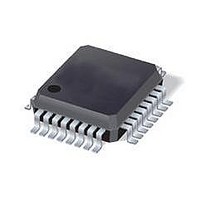ST7FLITE49K2T6 STMicroelectronics, ST7FLITE49K2T6 Datasheet - Page 145

ST7FLITE49K2T6
Manufacturer Part Number
ST7FLITE49K2T6
Description
IC MCU 8BIT 8K FLASH 32LQFP
Manufacturer
STMicroelectronics
Series
ST7r
Datasheet
1.ST7FLITE49K2T6TR.pdf
(245 pages)
Specifications of ST7FLITE49K2T6
Core Processor
ST7
Core Size
8-Bit
Speed
8MHz
Connectivity
I²C, SPI
Peripherals
LVD, POR, PWM, WDT
Number Of I /o
24
Program Memory Size
8KB (8K x 8)
Program Memory Type
FLASH
Eeprom Size
256 x 8
Ram Size
384 x 8
Voltage - Supply (vcc/vdd)
2.4 V ~ 5.5 V
Data Converters
A/D 10x10b
Oscillator Type
Internal
Operating Temperature
-40°C ~ 85°C
Package / Case
32-LQFP
Processor Series
ST7FLITE4x
Core
ST7
Data Bus Width
8 bit
Data Ram Size
384 B
Interface Type
I2C, SPI
Maximum Clock Frequency
8 MHz
Number Of Programmable I/os
24
Number Of Timers
4
Maximum Operating Temperature
+ 85 C
Mounting Style
SMD/SMT
Development Tools By Supplier
ST7FLITE-SK/RAIS, ST7FLI49M-D/RAIS, STX-RLINK
Minimum Operating Temperature
- 40 C
On-chip Adc
10 bit, 10 Channel
For Use With
497-8399 - BOARD EVAL ST7LITE49M/STLED316S497-5858 - EVAL BOARD PLAYBACK ST7FLITE
Lead Free Status / RoHS Status
Lead free / RoHS Compliant
Available stocks
Company
Part Number
Manufacturer
Quantity
Price
Company:
Part Number:
ST7FLITE49K2T6
Manufacturer:
ST
Quantity:
3 000
Company:
Part Number:
ST7FLITE49K2T6
Manufacturer:
STMicroelectronics
Quantity:
10 000
Company:
Part Number:
ST7FLITE49K2T6TR
Manufacturer:
STMicroelectronics
Quantity:
10 000
ST7LITE49K2
Note:
Master transmitter
Following the address transmission and after SR1 register has been read, the master
sends bytes from the DR register to the SDA line via the internal shift register.
The master waits for a read of the SR1 register followed by a write in the DR register,
holding the SCL line low (see
When the acknowledge bit is received, the interface sets EVF and BTF bits with an interrupt
if the ITE bit is set.
To close the communication: after writing the last byte to the DR register, set the STOP bit to
generate the Stop condition. The interface goes automatically back to slave mode (M/SL bit
cleared).
Error cases
●
●
●
In all these cases, the SCL line is not held low; however, the SDA line can remain low if the
last bits transmitted are all 0. It is then necessary to release both lines by software. The SCL
line is not held low while AF=1 but by other flags (SB or BTF) that are set at the same time.
BERR: Detection of a Stop or a Start condition during a byte transfer. In this case, the
EVF and BERR bits are set by hardware with an interrupt if ITE is set.
Note that BERR will not be set if an error is detected during the first pulse of each 9-bit
transaction:
Single Master mode
If a Start or Stop is issued during the first pulse of a 9-bit transaction, the BERR flag will
not be set and transfer will continue however the BUSY flag will be reset. To work
around this, slave devices should issue a NACK when they receive a misplaced Start or
Stop. The reception of a NACK or BUSY by the master in the middle of communication
gives the possibility to reinitiate transmission.
Multimaster mode
Normally the BERR bit would be set whenever unauthorized transmission takes place
while transfer is already in progress. However, an issue will arise if an external master
generates an unauthorized Start or Stop while the I
9-bit transaction. It is possible to work around this by polling the BUSY bit during I
master mode transmission. The resetting of the BUSY bit can then be handled in a
similar manner as the BERR flag being set.
AF: Detection of a non-acknowledge bit. In this case, the EVF and AF bits are set by
hardware with an interrupt if the ITE bit is set. To resume, set the Start or Stop bit.
The AF bit is cleared by reading the I2CSR2 register. However, if read before the
completion of the transmission, the AF flag will be set again, thus possibly generating a
new interrupt. Software must ensure either that the SCL line is back at 0 before reading
the SR2 register, or be able to correctly handle a second interrupt during the 9th pulse
of a transmitted byte.
ARLO: Detection of an arbitration lost condition.
In this case the ARLO bit is set by hardware (with an interrupt if the ITE bit is set and
the interface goes automatically back to slave mode (the M/SL bit is cleared).
Figure 71
Transfer sequencing EV8).
2
C master is on the first pulse of a
On-chip peripherals
145/245
2
C














